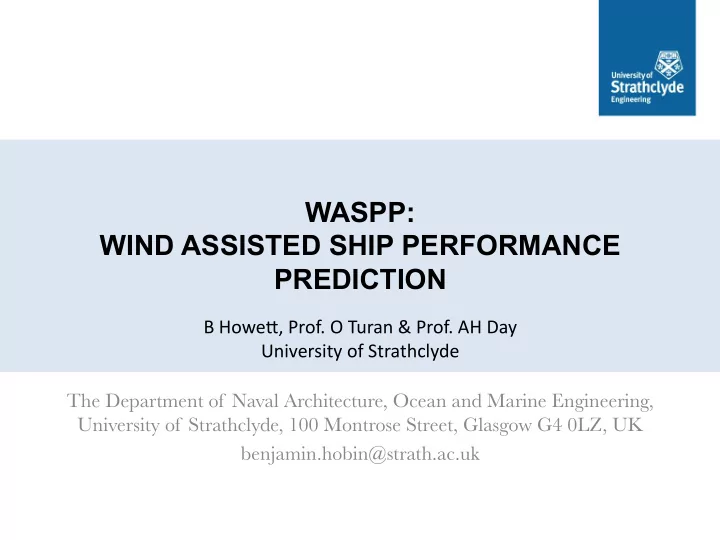

WASPP: WIND ASSISTED SHIP PERFORMANCE PREDICTION B Howe', Prof. O Turan & Prof. AH Day University of Strathclyde The Department of Naval Architecture, Ocean and Marine Engineering, University of Strathclyde, 100 Montrose Street, Glasgow G4 0LZ, UK benjamin.hobin@strath.ac.uk
WASPP: Background • Variant on a traditional yacht Velocity prediction program • Calculates all Aerodynamic and Hydrodynamic forces • Resolves force vectors and moments around ship axis • Balances forces so accelerations are zero • 4 DOF solution – (Surge), Sway, Roll, Yaw
WASPP: Development Background • Full GUI • Developed in C# using .NET Framework 4.5 • Some functionality also exposed • Currently compiled for windows only to .dll interface to link with external • Possible to use Mono for OSX / programs Linux
WASPP: Background • Fleet • Ship parameters • Design Conditions • Rig Size • Rig layout • Operating Conditions • Ship speed • Draft? • Environment Conditions • True wind speed • True wind angle • Driving force – Drag = 0 • Significant wave height • Heeling moment – Righting moment = 0 • True wave angle • Aero side force – Hydro side force = 0 • Aero yaw force – Hydro yaw force = 0 • Inputs • Pitch? • Heel • Heave? • Leeway • Would require full LPP to recalculate hullform • Engine power parameters at each condition • Rudder angle • Could be simplified and approximated with change in Sc • Sail Trim • Effects too small to consider
WASPP: Resistance & Powering • Hull • Calm water Upright Resistance – Holtrop 1984 – Holtrop & Mennen 1982 Resistance curve input – • Added resistance in waves – Modified Kwons Method - Lu 2014 Resistance polar input – • Added resistance due to wind – Blendermann 1996 – Fujiwara 2006 • Added Resistance due to Heel – Approximation based on changing wetted surface area • Sideforce & Added resistance due to Yaw – Journee & Clarke 2005 – Fujiwara 2006 – Shentzle 1985, Kuttenkueler 2007 • Rudder – Assumed NACA 0018 section – Fujiwara et al 2005 • Propeller – Wageningen B-series
WASPP: Sizing • Can accept direct dimensional inputs • …or if needed it can also create an 9000 8000 assumed ‘ideal’ sailplan. 7000 • Traditionally sailing yachts make use of two 6000 principle methods for initial sizing of sailplans. Sail Area 5000 – Stability at large heel angles 4000 – Sail Area/Displacement and Sail Area/Wetted 3000 Surface Area . 2000 1000 • Polynomial fit from database of ~100 sailing 0 yachts >50m 0 50 100 150 200 LOA • Modified based on wind assist assumptions • Verified against known vessels
WASPP: Rotor • Model: • Wind tunnel data (Prandtl & Betz 1932) • Single coefficient input (Traut 2014) • Lift Coefficient Curve (Craft 2012) • Parameters: • Rotational Speed 1200 • Stow • Sizing: 1000 (for ~180m Bulk Carrier) 800 • Total area: Total Area 600 • Height : • Width: 400 • Stack: 200 0 0 100 200 300 400 Length
WASPP: Sail • Model • Gretch La Rossa 2012 • Fugiwara 2005 • Parameters • Reef • Sizing 16000 (for ~180m Bulk Carrier) 14000 • Area = 1686m 2 12000 • Masts = 2 10000 • Mast height = 46m Sail Area • Yard length = 18m 8000 6000 4000 2000 0 0 100 200 300 400 LOA
WASPP: Kite • Model • Zero Mass Model ( Wellicome, Dadd and Hudson 2009) – Parametric figure-8 flightpath (Dadd 2012) Lift Coefficient Polar (Dadd 2012) • – Parameters • Drop! 1600 • Line Length? Flight Path? 1400 • Sizing 1200 (for ~180m Bulk Carrier) 1000 • Total Area: 257m 2 Total Area • Line Length: 300m 800 600 400 200 0 0 100 200 300 400 LOA
WASPP: Outputs • Outputs • Results can be analysed within WASPP or exported to either the popular • CSV (comma separated variable) • netCDF (multidimensional scientific data matrix • dll interface (run analysis from other programs - eg excel VBA)
WASPP: Usage • Individual case analysis
WASPP: Usage • Global performance analysis • Voyage Level Model – Evaluates performance across many voyages – Multiple Departure dates / Weather conditions – Multiple Routes
WASPP: Usage • Global performance analysis • Voyage Level Model – Evaluates performance across many voyages – Multiple Departure dates / Weather conditions – Multiple Routes
Recommend
More recommend